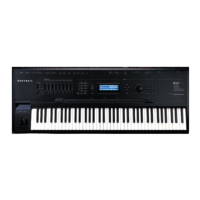Editing Conventions
Introduction to Editing
5-1
Chapter 5
Editing Conventions
Introduction to Editing
Editing programs, setups and songs on the PC3LE always involves three basic operations: mode
selection, navigation, and data entry.
First, select the mode that relates to the object you want to edit—a program, a setup, etc. Then
select the object you want to edit, and press the Edit button to enter the editor within that mode.
For programs, setups, songs, and quick access banks, these objects are “selected” when you are
on the main page of their corresponding mode. In these cases you can press the Edit button with
anything selected on their main page to access their editor. Often their will be more objects
inside of these “main page” editors, such as shift patterns and velocity patterns, and they can be
edited by selecting their parameter with the cursor and pressing the Edit button. An editor
contains all the parameters that define the object you’re programming.
Next, navigate around the editor’s page(s) with the soft buttons and select parameters with the
cursor (arrow) buttons. When you’ve selected a parameter (its value is highlighted by the
cursor), you can change its value with one of the data entry methods. When you change a value,
you’ll normally hear its effect on the object you’re editing. The PC3LE doesn’t actually write
your editing changes to memory until you save the object you’re working on. It then allows you
to choose between writing over the original object, or storing the newly edited version in a new
memory location.
What’s an Object?
If you’ve been wondering what we mean by the term “object,” it’s an expression we use for
anything that can be named, saved, deleted, or edited. A complete list of the latest PC3LE
factory objects can be found at kurzweil.com. Here’s a list of all the types of objects:
Programs Factory-preset or user-programmed sounds stored in ROM or flash
memory. A program is one or more layers of sound generated by samples
or oscillators, which is then routed through digital signal processing.
Setups Factory-preset or user-programmed MIDI performance presets consisting
of up to 16 zones, each with its own program, MIDI channel, and
controller assignments, and (optionally) arpeggiation and/or riff
specifications.
Songs Sequence files loaded into memory, or MIDI data recorded in Song mode.
Quick Access banks Factory-preset or user-programmed banks of ten entries each, that store
programs and setups for single-button access in Quick Access mode.
Shift patterns Factory-preset or user-programmed sequences of note shift information,
used by the arpeggiator for detailed arpeggiations, or by the Shift Key
Number controller destination.
Velocity patterns Factory-preset or user-programmed sequences of note velocity shift
information, used by the arpeggiator for detailed velocity triggering in
arpeggiation.

